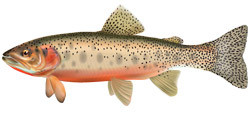
The Fish Sustainability Index (FSI) combines scientific and local knowledge to assess the health of Westslope Cutthroat Trout in Alberta.
Westslope Cutthroat Trout FSI Maps
Adult Density (Current and Historic)
- Current Adult Density Fish Sustainability (FSI) Rankings for Westslope Cutthroat Trout
- Historic Adult Density Fish Sustainability (FSI) Rankings for Westslope Cutthroat Trout
Please note that data reliability is not currently displayed in these figures.
Habitat and Overharvest Protection Needs
- Habitat Protection Needs Fish Sustainability (FSI) Rankings for Westslope Cutthroat Trout, 2013
- Overharvest Protection Needs Fish Sustainability (FSI) rankings for Westslope Cutthroat Trout, 2013
Please note that data reliability is not currently displayed in these figures. Further, threats were only ranked for known pure Westslope Cutthroat Trout populations.
The complete FSI spatial data layers can be viewed and downloaded in:
Westslope Cutthroat Trout Population Status
Westslope Cutthroat Trout have shown severe declines from historical abundances and existing populations of pure Westslope Cutthroat Trout are now small and fragmented. Westslope Cutthroat Trout are ranked as Threatened under the provincial Wildlife Act, and as Threatened by the national Committee on the Status of Endangered Wildlife in Canada (COSEWIC). The 2017 Alberta Fish Sustainability Index (FSI) assessment (excluding National Parks) reaffirmed these conservation designations, with all populations being classified as high risk. Reducing angling related mortality, more effective management of invasive trout and land use issues in key watersheds will be important in conserving and recovering Alberta's native Cutthroat Trout.
Historically, of the 104 watersheds within their native Alberta range, Westslope Cutthroat Trout were believed to be abundant in 71 watersheds. Numerous watersheds on the fringe of core Westslope Cutthroat Trout range held fish, but likely at lower densities as naturally warmer waters likely limited populations to low densities.
As of 2017, Westslope Cutthroat Trout (non-hybridized with Rainbow Trout or other introduced trout) are only found in 31 watersheds and were all assessed as either low or very low abundance of adult fish (see, the Current Adult Density Fish Sustainability (FSI) Rankings for Westslope Cutthroat Trout PDF found above). Healthy populations remain in isolated creeks but no longer exist within an entire watershed. However, with the refinement of genetic methods and as new results become available, Alberta biologists suspect the number of remaining pure populations may be even lower.
Threats to Sustainability
The main threats to sustainability of Westslope Cutthroat Trout are:
- Hybridization: Genetic introgression by non-native Rainbow Trout, Cutthroat Trout and other introduced trout threaten pure populations and limit their recovery potential. Further, non-native trout and char can act as competitors to Westslope Cutthroat Trout.
- Harvest: Sport fishing, even catch and release, when combined with other activities on the landscape might cause enough accidental mortality to prevent recovery of the remaining vulnerable populations.
- Habitat: Heavy land use and development including forestry, oil and gas, agriculture, and urbanization are associated with poor Westslope Cutthroat Trout status. Changes to water quality and quantity, stream fragmentation, sedimentation and loss of riparian cover may be causes of declines and failures of recovery. The effects of these land-use activities may be exacerbated with climate change.
Next Steps
- Hybridization: Extensive genetic monitoring is ongoing to identify and monitor pure populations and inform restoration actions. Efforts may include invasive fish removal programs in conjunction with restoration re-stocking of appropriate pure Westslope Cutthroat Trout.
- Harvest: Angling pressure in the East Slopes has the potential to prevent recovery of already depressed Westslope Cutthroat Trout populations. Although catch and release mortality may occur at a low rate, the combination of many anglers and few fish may pose too much of a high risk. Studies of potential management actions are being conducted which may include angling restrictions, season changes and gear restrictions.
- Habitat: Ongoing restoration work remains a focus, with activities such as reducing sediment inputs, improving trail crossings, reducing linear disturbance, removing fish barrier culverts where appropriate and riparian stabilization. Increasing resiliency to climate change will become a key component of preserving Westslope Cutthroat Trout into Alberta's future. Cooperation between government agencies, industries and stakeholders to address land use issues will be key in achieving success.
- Successful recovery will require extensive work as well as collaboration between government, Indigenous peoples, anglers, landowners, industry and other stakeholders. However, to ensure long-term success, these programs must address the root causes of Westslope Cutthroat Trout declines and undertake specific recovery actions based on major threats within each watershed.